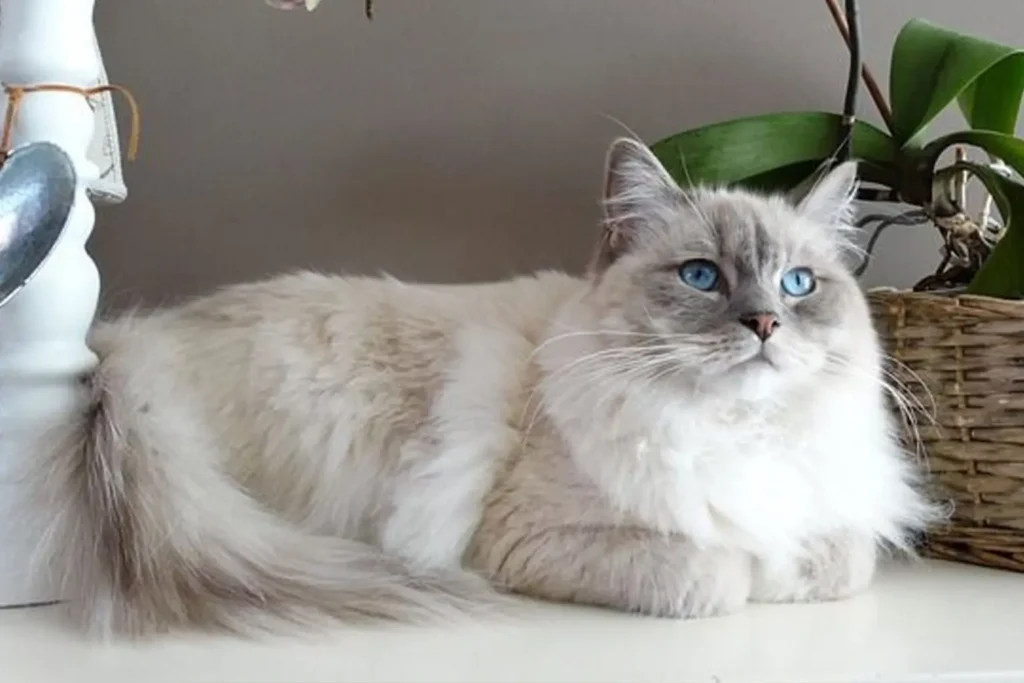
Ragdoll Cat
Ragdoll cats are gentle affectionate companions with unique dietary needs to match their large size. Their slow growth rate means they need nutrient rich food to support steady development. Feeding your Ragdoll cat meals rich in real protein helps keep their muscles strong and their fur soft to the touch.
They can be prone to weight gain, so controlled portions are essential. Adding Omega fatty acids supports their joints and keeps their fur soft and shiny. At tayyibcats, we share trusted tips to keep your Ragdoll happy and healthy in every stage of life.
The ragdoll cat is one of the most affectionate and beautiful feline breeds, admired for its silky coat, calm personality, and captivating blue eyes. Whether you’re in Dubai, KSA, or anywhere in the world, ragdoll cat breeds are known for being the ideal indoor companion. From the blue mitted ragdoll cat to the seal point ragdoll cat, these cats win hearts with their easygoing nature. This blog will walk you through everything you need to know about caring for a ragdoll, including feeding, health issues, grooming, and more perfect for cat lovers in the UAE and beyond.
Caring for a Ragdoll
Taking care of a ragdoll cat involves consistent grooming, scheduled feeding, and lots of affection. Their docile nature makes them easy to manage, but their long coats require regular brushing, especially for varieties like the grey ragdoll cat or flame point ragdoll cat. In both Dubai and KSA, owners must pay close attention to hydration due to the dry climate. Whether it’s a ragdoll mix cat or a black ragdoll cat blue eyes, all need proper shelter, stimulation, and vet care to thrive.
Ragdoll Cat Health Issues
Ragdoll cats are generally healthy but may suffer from genetic conditions like hypertrophic cardiomyopathy or urinary tract issues. Ragdoll cat lifespan typically ranges from 12 to 17 years. Regular checkups, especially for older cats like the ragdoll cat age category of 10+, are crucial. Look out for signs of obesity or joint pain in ragdoll cat size comparisons. Health monitoring is essential whether you have a birman ragdoll cat, persian ragdoll cat, or even a ragdoll himalayan cat.
What To Feed a Ragdoll
Choosing the best food for ragdoll cats means selecting high protein, low carb diets. Wet food supports hydration ideal for owners in KSA and Dubai where dehydration is a risk. Popular feeding options include vet recommended dry food for ragdoll cat grooming and coat health. Keep your baby ragdoll cat on kitten specific formulas until fully matured. Nutrient-rich food is essential for exotic mixes like munchkin ragdoll cat and ragdoll siamese cat personality types.
How To Feed a Ragdoll
Ragdoll cats do best with scheduled feeding twice a day. Offer food in shallow bowls to prevent whisker fatigue. If your cat is a red mitted ragdoll cat or lilac mitted ragdoll cat, make sure you follow a balanced feeding pattern that supports color and coat health. In warm climates like Dubai, always provide fresh water and avoid leaving wet food out for long.
How Much Should You Feed a Ragdoll?
The portion depends on the ragdoll cat size and age. On average, adult ragdoll cats eat 250–300 calories per day. The ragdoll munchkin cat price may be high, but their care needs are the same as standard breeds. Use weight charts to manage feeding, especially for types like lilac ragdoll cat or ragdoll ginger cat which may have different activity levels.
Nutritional Tips for Ragdolls
- Include omega-3 fatty acids for coat shine
- Offer grain-free food for ragdoll cat lifespan optimization
- Avoid fillers that cause obesity in flame point ragdoll cat types
- Introduce probiotics for gut health
- Feed consistently with premium protein diets for cats like black and white ragdoll cat
Behavior and Training Tips for Ragdoll
The ragdoll cat personality is calm, gentle, and social. These cats can be trained easily using positive reinforcement. Start early if you have a doll cats ragdoll breed or ragdoll cat teacup munchkin cat. Mental stimulation is key to avoiding boredom. Ragdoll cat images often show them relaxed, but they love playing too.
Ragdoll Behavior
Expect a quiet, laid back companion. The ragdoll cat temperament is one of the most docile among felines. Whether it’s a ragdoll ragamuffin cat, a seal mitted ragdoll cat, or a tortie ragdoll cat, these breeds adapt easily to families and children. Their affectionate nature also makes them ideal for multi-pet households in Dubai or KSA.
Ragdoll Training
Use simple clicker training and treats to teach your ragdoll cat commands and litter discipline. Cutest ragdoll cats often respond well to vocal cues. Socializing a blue ragdoll cat or ragdoll cat patronus (as some affectionately call them) early helps prevent anxiety.
Fun Activities for Ragdoll Cats
- Feather wand play for seal point ragdoll cat types
- Puzzle toys for ragdoll cat age enrichment
- Window perches for blue mitted ragdoll cat entertainment
- Hide and seek games with ragdoll cat stuffed animal toys
- Playdates for social ragdoll cats in KSA apartments
Ragdoll Cats Grooming
Grooming is crucial for maintaining the beauty of a gray ragdoll cat, brown ragdoll cat, or lilac point ragdoll cat. Brush at least 2–3 times a week using a slicker brush. Watch for mats under the armpits and behind ears. Routine grooming extends ragdoll cat life expectancy and reduces shedding. For persian cat mixed with ragdoll, grooming becomes even more essential.
The ragdoll cat breed is ideal for those seeking a loving, low maintenance feline companion. From their ragdoll cat origin to their modern day popularity in places like Dubai and KSA, these cats continue to win hearts globally. Whether you’re drawn to the ragdoll ginger cat, blue mitted ragdoll cat, or seal mitted ragdoll cat, the charm of these cats is undeniable. Choose wisely, care passionately, and enjoy the lifelong affection of your ragdoll cat.
